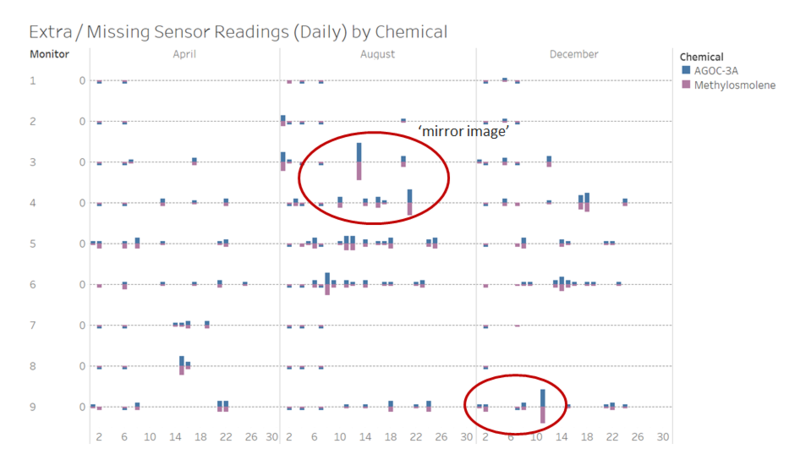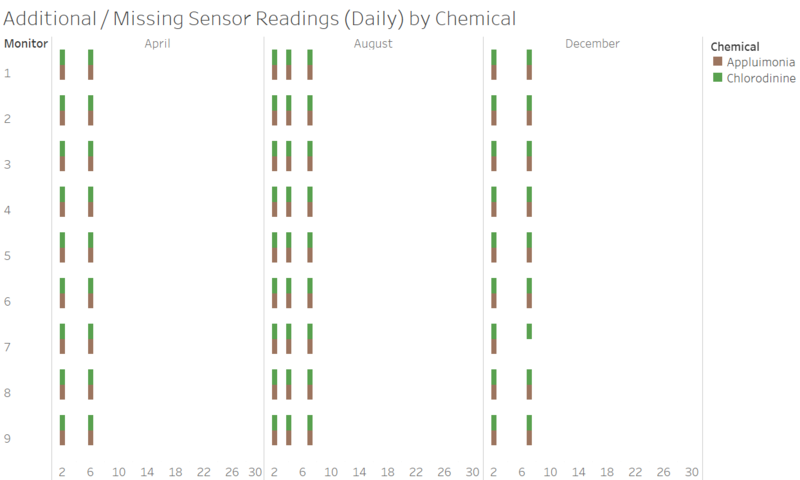Assign NGO SIEW HUI Q1
|
|
|
|
|
|
|
|
Question 1
Characterize the sensors' performance and operation. Are they all working properly at all times? Can you detect any unexpected behaviors of the sensors through analyzing the readings they capture? Limit your response to no more than 9 images and 1000 words.
Response
As the sensors were supposed to be taking readings at every hour of the day, it would be interesting to find out if there were any missing records. Hence, a dashboard was developed with interactive filters (i.e. select sensor, month and chemical) to enable the viewing of captured readings on an hourly basis. The visualisation was in the form of a trellis chart to facilitate a single view of the selected month, with each day of the month represented by each panel.
Note that this chart was designed to provide a quick overview of the data gaps (if any), and it was not meant for analysing the sensor readings (refer to Question 2 for analysis of the readings). Hence, the scale of the y-axis for the sensor readings had been adjusted accordingly, i.e. the plotted lines were 'flatten' in order to spot the missing records easily.
Sample View of Dashboard: Hourly Time Series of Sensor Readings
Observation 1: There were indeed many missing records spread across all 3 months of data (April, August and December), and also across all 9 sensors and 4 chemicals. From the above image, it was clear that quite a few readings were missing from Sensor 9 for chemical Methylosmolene on 11 December 2016.
After establishing that there were missing records from the Sensor Data, the next step would be to analyse the number of records captured per day (break-down by sensors and chemicals). Hence, a dashboard was developed to view the deviations from the expected number of records, on the basis that there should be 24 readings expected per day for the selected chemical and sensor. To obtain the deviation from the expected number of records, a new calculated field was created (i.e. 'count of records' minus 24). Note that interactive filters were added on the dashboard to enable the selection of a single / multiple chemical(s).
Sample View of Dashboard: Extra / Missing Sensor Readings by Chemical (Daily View)
Observation 2: Aside from the missing records, it became clear from the dashboard that there were extra records present in the data for chemical AGOC-3A, as evident by the number of records captured per day being greater than 24 for each sensor (i.e. positive deviations, above the zero-axis line). From the above image, it was noted that the extra records were spread across the sensors and days, but there were 2 days (i.e. 13 August and 11 December) with particularly high number of extra records (i.e. 10 and 9 extra records respectively).
Note: This also highlighted the undesirable situation that there were more than one single record for a particular sensor, chemical and hour of the day. Hence, considerations should be made during downstream analysis (e.g. avoid double-counting of sensor readings which would skew the analysis).
Sample View of Dashboard: Extra / Missing Sensor Readings by Chemical (Daily View)
Observation 3: When both chemicals, AGOC-3A and Methylosmolene, were selected on the dashboard, it was observed that the number of missing records for Methylosmolene matched the number of extra records for AGOC-3A, and hence a mirror image was observed in the chart. This might be due to a system bug which had wrongly recorded the readings for Methylosmolene against AGOC-3A instead.
Hence, it is recommended that further checks should be conducted by the operations team to investigate this discrepancy in sensor readings.
We used the above dashboard to view the no. of extra / missing records for the other two chemicals, Appluimonia and Chlorodinine.
Observation 4: There were missing records for Appluimonia and Chlorodinine which had occurred during the same days within each month. For example, missing records were observed on the 2nd and 6th day of April across all 9 sensors. This might be due to a system bug or it could be some system maintenance process which led to all sensors not being able to capture readings during those days.
To access the interactive version of the above dashboards, please go to the following URL on Tableau Public:
[Placeholder]




